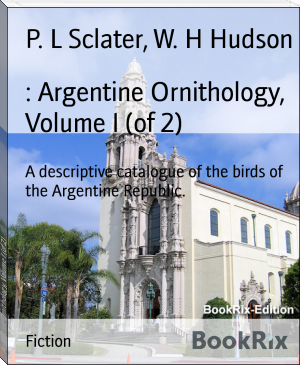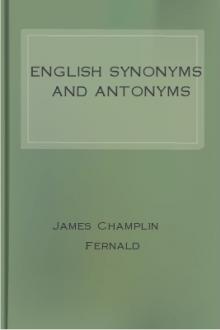: Argentine Ornithology, Volume I (of 2), P. L Sclater, W. H Hudson [best authors to read txt] 📗

- Author: P. L Sclater, W. H Hudson
Book online «: Argentine Ornithology, Volume I (of 2), P. L Sclater, W. H Hudson [best authors to read txt] 📗». Author P. L Sclater, W. H Hudson
+Stelgidopteryx ruficollis+, _Sharpe, Cat. B._ x. p. 208. +Cotile
ruficollis+, _Barrows, Bull. Nutt. Orn. Cl._ viii. p. 90.
_Description._--Above brown, head darker, rump paler; wings and tail
blackish brown, coverts edged with pale brown, external secondaries
margined with whitish; beneath pale ashy brown; throat rufous;
middle of belly pale yellowish; crissum white, tipped with black:
total length 5·0 inches, wing 4·3, tail 2·0. _Female_ similar.
_Hab._ South America.
Mr. Barrows tells us that this species is abundant in Entrerios
throughout the summer, arriving from the north early in August, and
is said to nest in holes in banks.
Fam. IX. (TANAGRIDÆ, or TANAGERS.)
The brilliant family of Tanagers, one of the most characteristic groups
of the American avifauna, contains altogether nearly 400 species, of
which the greater number are restricted to the forest-clad districts of
Central and South America between the tropics. South of the Tropic of
Cancer the number of species met with falls off very considerably, so
that in the Argentine Republic only fourteen members of the family have
as yet been recognized. This number will, however, be probably increased
when the less-known wooded districts of northern and eastern Argentina
have been more fully explored.
The fourteen species of Argentine Tanagers belong to ten different
genera, mostly of wide distribution. But to this rule one genus
(_Stephanophorus_) is an exception, being only found in Southern
Brazil, Paraguay, Uruguay, and Northern La Plata.
33. EUPHONIA NIGRICOLLIS (Vieill.). (BLACK-NECKED TANAGER.)
+Euphonia nigricollis+, _Scl. Cat. B._ xi. p. 61. +Lindo azul y oro
cabeza celeste+, _Azara, Apunt._ i. p. 390. +Euphonia aureata+,
_d'Orb. Voy., Ois._ p. 267 (Corrientes).
_Description._--Above glossy purplish black; rump yellow; cap and
nape blue; front black; below orange-yellow, throat and sides of
the head black; axillaries pale yellow; under wing-coverts whitish,
inner margins of wing-feathers pale cinereous; bill black; feet pale
brown: whole length 4·5 inches, wing 2·7, tail 1·5. _Female_ above
olive-green, rather lighter on the rump; cap blue; front chestnut,
with a narrow dark margin between it and the blue cap; below
yellowish olive-green, brighter on the belly.
_Hab._ South America from Colombia to Northern Argentina.
This Tanager was obtained by d'Orbigny in Southern Corrientes.
34. EUPHONIA CHLOROTICA (Linn.). (PURPLE-AND-YELLOW TANAGER.)
+Euphonia chlorotica+, _Scl. et Salv. Nomencl._ p. 17; _White, P. Z.
S._ 1882, p. 596 (Misiones, Catamarca); _Scl. Cat. B._ xi. p. 64.
_Description._--Above dark purple-black; front half of the cap
yellow; below yellow, throat purple-black; tail beneath black,
with a large white patch on the inner webs of the two exterior
tail-feathers; under surface of wings black, with a large white
patch on the inner webs of the remiges; bill and feet black: whole
length 3·3 inches, wing 2·1, tail 1·2. _Female_ above greyish
olive-green, with a yellowish tinge on the front and rump; below
rather more yellowish, with the centre of the breast and belly pale
ashy, flanks and crissum pale yellow; under wing-coverts and inner
margins of wing-feathers whitish.
_Hab._ Guiana, Brazil, Paraguay, and Northern Argentina.
White obtained examples of this species at Concepcion and Catamarca. At
the former place it was noticed feeding on the fruit of a giant cactus.
35. PIPRIDEA MELANONOTA (Vieill.). (DARK-BACKED TANAGER.)
+Pipridea melanonota+, _Scl. Cat. B._ xi. p. 92. +Pica de punza azul
y canela+, _Azara, Apunt._ i. p. 413.
_Description._--Above violaceous blue; while interscapular region
darker, blackish; wings and tail black, edged with blue; narrow
front, lores, and sides of the head deep velvety black, well
defined; body beneath and under wing-coverts clear ochraceous; under
surfaces of wings and tail blackish; bill black; feet brown: whole
length 5·8 inches, wing 3·1, tail 2·2. _Female_ above dark brown,
tinged with blue on the head and rump; below like the male.
_Hab._ South America from Venezuela to Paraguay and Northern Argentina.
This Tanager, which was found by Azara in Paraguay, occurs in Tucuman.
An adult male obtained by Herr Schulz in this province is in the
collection of Hans, Graf von Berlepsch.
36. STEPHANOPHORUS LEUCOCEPHALUS (Vieill.). (WHITE-CAPPED TANAGER.) [Plate IV.]
+Stephanophorus leucocephalus+, _Scl. et Salv. Nomencl._ p. 20;
_Durnford, Ibis_, 1877, p. 170 (Buenos Ayres); _White, P. Z. S._
1882, p. 597 (Misiones); _Barrows, Bull. Nutt. Orn. Cl._ viii.
90 (Concepcion); _Scl. Cat. B._ xi. p. 143. +Stephanophoruscœruleus+, _Burm. La-Plata Reise_, ii. p. 480 (Paraná).
_Description._--Uniform deep blue; cap silky white, with a small
crimson crest; bill brownish black, feet brown: whole length 7
inches, wing 4, tail 3·3. _Female_ similar, but not quite so bright
in colour.
_Hab._ Southern Brazil, Paraguay, and Northern Argentina.
Azara gave the generic name _Lindo_ (beautiful) to the Tanagers, and
this species he named the "Blue White-headed Beautiful," the entire
plumage being of a very lovely deep corn-flower blue, except a cap of
silvery-white feathers on the head, with a crimson spot on the forehead,
looking like a drop of blood.
It is a summer bird in Buenos Ayres, where it makes its appearance in
spring in the woods bordering on the Plata river, and is usually seen
singly or in pairs. The nest is built in a tree ten or twelve feet from
the ground, and is somewhat shallow and lined with soft dry grass.
The female lays four eggs, white and spotted with deep red. During
incubation the male sits concealed in the thick foliage close by,
amusing itself by the hour with singing, its performance consisting of
chattering disconnected notes uttered in so low a tone as to make one
fancy that the bird is merely trying to recall some melody it has
forgotten, or endeavouring to construct a new one by jerking out
a variety of sounds at random. The bird never gets beyond this
unsatisfactory stage, however, and must be admired for its exquisite
beauty alone.
37. TANAGRA SAYACA, Linn. (BLUE TANAGER.)
+Tanagra cyanoptera+, _Durnford, Ibis_, 1878, p. 59 (Buenos Ayres);
_Barrows, Bull. Nutt. Orn. Cl._ viii. p. 91 (Concepcion); _Scl.
Cat. B._ xi. p. 157 (part.). +Tanagra sayaca+, _Burm. La-Plata
Reise_, ii. p. 479 (Paraná); _Berl. Zeitschr. ges. Orn._ 1885,
119, _Scl. Cat. B._ xi. p. 158.
_Description._--Bluish grey, paler below; wings and tail blackish,
edged with greenish blue; lesser wing-coverts dull greenish blue,
like the edgings of the wings; bill plumbeous, feet brown: whole
length 6·0 inches, wing 3·6, tail 2·7. _Female_ similar.
_Hab._ S.E. Brazil and Argentina.
In the 'Catalogue of Birds' I referred the Argentine Blue Tanager to _T.
cyanoptera_, though expressing a doubt upon the subject. I am now
disposed to adopt Graf. v. Berlepsch's view that the Argentine species
rather belongs to _T. sayaca_.--P. L. S.
This species migrates as far south as Buenos Ayres, and appears in
spring, in small flocks or parties of three or four birds, in the woods
on the shores of the Plata. The male utters a series of peculiar
squealing notes by way of song.
38. TANAGRA BONARIENSIS (Gm.). (BLUE-AND-YELLOW TANAGER.)




Comments (0)